
 |
AIS 120: INDIANS OF THE AMERICAS |
IV. Invasion, Conquest, Rebellion
A. Invasion
1. Columbus and Guacanagari
The reasons that Europeans left their homelands in great numbers to seek fortunes in unknown lands were many. Disease and famine from 1100- 1500 was catastrophic. The disparity of classes and inheritance patterns limited wealth to first born sons, added to the fact that those that survived, were not satisfied with their plight. Portugal was granted an Eastern passage to Asia and Spain under Isabella and Ferdinand had just defeated the Moors at Grenada in Jan 1492 and decided to expel Jews a few months later. This imperialism and religious 'holy war' pattern developed out of the invasions by 'infidels', crusades and the need for increased commerce due to economic and ecological disasters for 400 years all over Europe. So Isabella and Ferdinand took a chance on a obscure mariner and map maker to try to find Asia via a Western passage. All of the notions that Columbus and his men were concerned about sailing off a flat earth were false embellishments perpetrated by many writers that persists today and still taught in schools. Columbus and his men may not have been clear on the existence of an entire continent between Europe and Asia, but it became clear that they in fact had found a different land they called the West Indies and later a 'New World'.
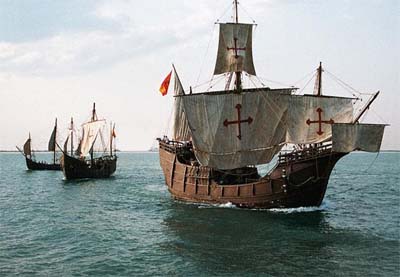 Santa
Maria, Pinta, Niña
Santa
Maria, Pinta, Niña
 Columbus/Colon
Columbus/Colon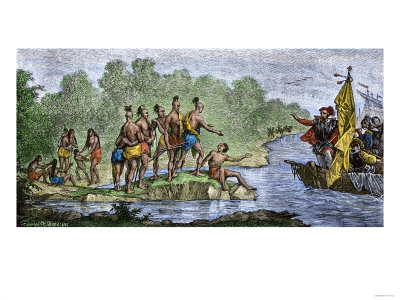 Landing
San Salvador 1492
Landing
San Salvador 1492
On October 12, 1492 Columbus with his three
ships the Santa Maria, Pinta, and Nina arrived on a small island
in the Bahamas. As he landed he claimed the territory for Spain by putting up a
flag, a cross and naming the islands, the first being San Salvador. The Indians
were Taino and Columbus found the people to be friendly so he manacled and
kidnapped 10-25 Indians. After they were captured they were read
what has been called the 'requerimiento' in Spanish,
a imperialistic justification for what has been called the "Doctrine of
Discovery". On the island
of Hispaniola, the flagship, the Santa Maria was washed up on the rocks
on Christmas Eve, 1492. The main cacique, Guananagari, of the Taino in the area
ordered his people to man canoes and rescue people and goods in the breakers.
The rescued shipwreck material was used to build a settlement called Navidad (for
Christmas day). Columbus left some of the men at Navidad on Hispaniola and
quickly returned to Spain on the Nina. Guanangari tried to help the
colony but other caciques resented the demands for food and gold and burned
Navidad and Guanangari's village. Columbus returned with more ships
and men on three more voyages.
of the Taino in the area
ordered his people to man canoes and rescue people and goods in the breakers.
The rescued shipwreck material was used to build a settlement called Navidad (for
Christmas day). Columbus left some of the men at Navidad on Hispaniola and
quickly returned to Spain on the Nina. Guanangari tried to help the
colony but other caciques resented the demands for food and gold and burned
Navidad and Guanangari's village. Columbus returned with more ships
and men on three more voyages.
|
Voyages of Columbus |
| Voyages and Dates | Men and Supplies | Area Explored |
| First Expedition 1492-1493 | 3 ships | Bahamas, Hispaniola, Cuba |
| Second Expedition 1493-1496 | 17 ships, 1,500 colonists | Cuba, Leeward Is., Puerto Rico |
| Third Expedition 1498-1500 | convicts | Trinidad, Venezuela |
| Fourth Expedition 1502 | 4 ships | Honduras, marooned in Jamaica |
Columbus enslaved around 2000 Taino and in 1495 when his demands for gold were not satisfactory, he declared all out war "with God's aid soon gained complete victory, killing many Indians and capturing others who were also killed". Columbus was never really satisfied with the spoils from Caribbean Indians who had relatively small amounts of gold. After his fourth voyage Columbus died in relative obscurity. The precedence for the treatment of Native peoples had been set and each time Spanish reached new native people they were under orders to read the requerimiento and if they did not swear allegiance to the Pope and Spanish Crown; then
" I certify to you that, with the help of God, we shall powerfully enter into your country and shall make war against you in all ways and manners that we can, and shall subject you to the yoke and obedience of the Church and of Their Highnesses. We shall take you and your wives and your children and shall make slaves of them, and as such shall sell and dispose of as them as Their Highnesses may command. And we shall take your goods, and shall do all the mischief and damage that we can, as to vassals who do not obey and refuse to receive their lord and resist and contradict him"
In most cases the Indians were not provided with translations and the Spanish did what they wanted. This attitude or what has been called the Doctrine of Discovery originated from a Papal Bull by Pope Nicolas V in 1452. Informally this is referred to as "God, Gold and Greed" and since conquerors did not really care whether Native American groups even understood what was being said and intended to destroy and enslave. Europeans were adamant that their culture was superior, thus justifying subjugation and destruction. This also held true for the natural world. However, Spanish treatment of Indians was backfiring since the colonies in Hispaniola and Cuba decimated Indian labor. Ultimately, African slave labor was needed to replace Indian slave labor. Also, the temptation of the mainland of Meso America became an overwhelming attraction.. Although, Columbus was not rewarded in Spain he was made a legend in America and initiated what has been referred to as the Columbian Exchange.
2. Cortes and Motecuhzuma II
Hernon Cortes (1485-1547)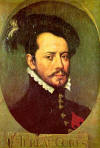 was a classic Spanish conquistador who came from
lesser nobility and was from the first generation of Spaniards involved in the conquest
of the Americas. Cortes came to Hispaniola in 1503 (age 18) and played a part in
subjugating the Native Americans in Cuba. Against a revocation, by Gov.
Velasquez, of orders Cortes led an expedition of 600 to the mainland of Mexico
in Feb 1519. By spring of 1519 Cortes had worked his way from Yucatan up the
coast to near today's Vera Cruz. Along the way Cortes had engaged a Nahuatl and
Chontal Maya
speaking woman named Malintzin (Malinche)
was a classic Spanish conquistador who came from
lesser nobility and was from the first generation of Spaniards involved in the conquest
of the Americas. Cortes came to Hispaniola in 1503 (age 18) and played a part in
subjugating the Native Americans in Cuba. Against a revocation, by Gov.
Velasquez, of orders Cortes led an expedition of 600 to the mainland of Mexico
in Feb 1519. By spring of 1519 Cortes had worked his way from Yucatan up the
coast to near today's Vera Cruz. Along the way Cortes had engaged a Nahuatl and
Chontal Maya
speaking woman named Malintzin (Malinche)
 who
proved a great value to the
expedition. Today, she is very controversial for having thrown in with the
Spanish. In Vera Cruz the first emissaries the Aztec ruler Motecuhzuma
(Montezuma) met with the Spanish. Motecuhzuma II or Motecuhzuma Xocoyotin had
risen to power in 1502 and the Aztec Empire which was a Triple Alliance of
powerful city states around Lake Texcoco ruled 50 city states in the Valley
of Mexico. The main city was Tenochtitlan that had a population of 200,000
people.
who
proved a great value to the
expedition. Today, she is very controversial for having thrown in with the
Spanish. In Vera Cruz the first emissaries the Aztec ruler Motecuhzuma
(Montezuma) met with the Spanish. Motecuhzuma II or Motecuhzuma Xocoyotin had
risen to power in 1502 and the Aztec Empire which was a Triple Alliance of
powerful city states around Lake Texcoco ruled 50 city states in the Valley
of Mexico. The main city was Tenochtitlan that had a population of 200,000
people.
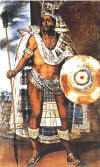 Motecuhzuma II
Motecuhzuma II
 Motecuhzuma's headdress
Motecuhzuma's headdress
 Aztec
Capital: Tenochititlan
Aztec
Capital: Tenochititlan
 Cortes
on the causeway into Tenochititlan
Cortes
on the causeway into Tenochititlan
Spanish accounts written later promoted many false 'legends' about the conquest of the Aztecs by a few hundred Spaniards. A common misconception is that the Aztecs thought Cortes was the returning diety Quetzalcoatl and the people were blinded by superstition. This is propaganda that purposefully portrays the Spanish as smarter and more rational than the Aztecs. The truth is that the Aztecs resisted and that they eventually were overwhelmed by mercenary Indian groups and European diseases.
When Motecuhzoma's emissaries brought offerings to the Spanish, Cortes had
them shackled. With the help of Malinche Cortes formed alliances with Totonac
and Tlaxcalans, enemies of the Aztecs and moved toward the Aztec Empire in Nov
1519 massacring any Indians in his way. When Cortes first entered the Aztec city
of Tenochtitlan, Motecuhzoma welcomed him as a guest with further gifts
and put him up in his father's palace. A native account observes that when they
gave the Spanish gold, "...they seemed to smile, to rejoice and be very happy.
Like monkeys they grabbed for the gold. It was as though their hearts were put
to rest, brightened, freshened. For gold was what they greatly thirsted for,
they were gluttonous for it...". For several months the Spanish remained as
guests, but in April 1520 Gov. Velasquez sent 18 ships under Capt. Narvaez
to arrest Cortes and return him to Cuba. Cortes had learned of this from Indian
messengers, attached Narvaez 's and his men, eventually convinced them to stay with
his expedition. Back in Tenochtitlan, Alvarado lost his temper and slaughtered
unarmed ceremonial participants (Massacre in the Great Temple). When Cortes returned with
several thousand ally Indians the Spanish were under siege in the palace. Since Motecuhzoma had allowed Cortes to return he was deposed and replace by his
brother, Cuitlahuac. Stories vary greatly as to what happened to Motecuhzuma.
Was he stoned by his own people (Spanish accounts)? Did the Spanish murder him
(Indian accounts)? We know that Alvarado murdered a number of Aztec nobles, but
we can not be sure Motecuhzuma was among the dead. On June 30, 1520 Cortes and
his men made a night retreat across the causeway over Lake Texcoco. Thousands of
Aztec warriors attached and Cortes and his men took heavy casualties, with many
drowning in the lake weighted down with gold looted from Motecuhzoma's treasury.
The Spanish call this 'Noche Triste' (Sad Night).
 Cortes and Alvarado both
survived and made it to Tlaxcala. By Dec 1520 Cortes had reinforcements and had
army of 700 Spaniards and 75,000 Indian warriors. It is believed that smallpox began to
take a toll of the people of Tenochtitlan. Cuitlahuac died, probably of smallpox
and a nephew, Cuauhtemoc
Cortes and Alvarado both
survived and made it to Tlaxcala. By Dec 1520 Cortes had reinforcements and had
army of 700 Spaniards and 75,000 Indian warriors. It is believed that smallpox began to
take a toll of the people of Tenochtitlan. Cuitlahuac died, probably of smallpox
and a nephew, Cuauhtemoc , succeeded and assembled an Aztec army of 50,000. Cortes
took the surrounding towns on Lake Texcoco and attached the city of Tenochtitlan
by boat and causeway. Cuautemoc and his warriors fought for three months. Cortes
was forced to level the city to create an open ground advantage not possible in
streets and buildings. It is thought that smallpox continued to take a toll with
the Aztec army and populous. Cuauhtemoc surrendered on Aug 13, 1521. The
Spaniards raped surviving women and demanded more gold tribute.
, succeeded and assembled an Aztec army of 50,000. Cortes
took the surrounding towns on Lake Texcoco and attached the city of Tenochtitlan
by boat and causeway. Cuautemoc and his warriors fought for three months. Cortes
was forced to level the city to create an open ground advantage not possible in
streets and buildings. It is thought that smallpox continued to take a toll with
the Aztec army and populous. Cuauhtemoc surrendered on Aug 13, 1521. The
Spaniards raped surviving women and demanded more gold tribute.
Over the next 20 years the Spanish continued to subject other Indian groups like the Tarascans of Michoacan and numerous Mayan groups. In Yucatan it took until 1547 to control Indian people. eventually the Spanish moved into Guatemala and other areas of Central America. In the 1540s Spanish conquistadors felt the need for more riches and sent expeditions to Florida, New Mexico and California. They were generally disappointed and North America's frontier was considered poor. The Spanish never identified the gold fields in California' Sierra Nevada Mountains, they merely named them.
The Spanish enslavement and destruction of the Native Americans continue unquestioned. A Dominican priest who had participated in in the conquest, Bartolome de Las Casas protested the treatment of Indians and wrote a sensational book, Destruction of the Indies ( 1547). The book had two important influences. First, it brought about a famous debate in Spain (1550-1551) between Bartolome de las Casas and one Juan Gines de Sepulveda to resolve the legal and ethical validity of enslaving Native Americans. Generally, de las Casas won but in reality no one obeyed any of the resulting edicts and some say it encouraged the enslavement of African people. However, Indian populations in the Caribbean had been reduced by 90% by 1550 and Africans were brought to America to replace Indian slaves that had died. This pattern continued well into the 19th century throughout the Americas.
3. Pizarro and Atahualpa
Atahualpa (Atabalipa) (1497-1533)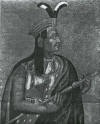 is considered to be the last sovereign emperor of the Inca Empire (Tahuantinsuyu-Land
of the Four Quarters). Even though he defeated his half brother, Huascar, he
was never officially installed. Atahualpa and Huascar were half brothers and
their father, Inca Huayana Capac died of smallpox along with many nobles
including the planned heir to the throne. Smallpox came from indirect contact
of the Spanish around 1525 probing into Panama and the coast of Ecuador. The
decimation of high ranking leaders created enough turmoil to launch a civil war
between Atahualpa in the north at Cajamarca and Huascar at Cusco. At the Battle
of Chimborazo and Quipaipan in 1532, Atahualpa's army of 80,000 defeated
Huascar's army that probably started with less than 50,000. As Atahualpa was
resting at Cajamarca, Pizzaro was just coming from Ecuador.
is considered to be the last sovereign emperor of the Inca Empire (Tahuantinsuyu-Land
of the Four Quarters). Even though he defeated his half brother, Huascar, he
was never officially installed. Atahualpa and Huascar were half brothers and
their father, Inca Huayana Capac died of smallpox along with many nobles
including the planned heir to the throne. Smallpox came from indirect contact
of the Spanish around 1525 probing into Panama and the coast of Ecuador. The
decimation of high ranking leaders created enough turmoil to launch a civil war
between Atahualpa in the north at Cajamarca and Huascar at Cusco. At the Battle
of Chimborazo and Quipaipan in 1532, Atahualpa's army of 80,000 defeated
Huascar's army that probably started with less than 50,000. As Atahualpa was
resting at Cajamarca, Pizzaro was just coming from Ecuador.
Francisco Pizzaro (1471-1541) was from Trujillo, Spain and the illegitimate
son of Gonzalo Pizarro Rodriguez (1446-1522), a military officer, and Francisca
Gonzalez Mateo. Pizzaro left Spain in 1502 and spent 2 years in Hispaniola. He
set out with in 1513 with the Balboa expedition to cross the Isthmus of Panama.
Pizzaro settled in Panama and became associated with Pedrarias Davila who did
not trust Balboa and actually had Pizzaro arrest Balboa (he was convicted and
executed in 1519). This loyalty was repaid and Davila was made mayor of Panama
City from 1519-1523. In 1524 Pizzaro formed a partnership with a priest Hernando
de Luque and a soldier, Diego de Almagro to conquer lands to the south. They
made three troubled expeditions in 1524, 1526 and 1530. Earlier failures
forced Pizarro to make a trip to Spain to solicit Charles V for support and he
got his brothers to go with him. Pizarro landed in Ecuador and after the Battle
of Puna against Punian Indians he was joined by Hernando de Soto they
established a settlement called San Miguel de Piura in July of 1523. It was
Hernando de Soto that on an exploration mission returned with an Incan envoy
from Atahualpa.
was from Trujillo, Spain and the illegitimate
son of Gonzalo Pizarro Rodriguez (1446-1522), a military officer, and Francisca
Gonzalez Mateo. Pizzaro left Spain in 1502 and spent 2 years in Hispaniola. He
set out with in 1513 with the Balboa expedition to cross the Isthmus of Panama.
Pizzaro settled in Panama and became associated with Pedrarias Davila who did
not trust Balboa and actually had Pizzaro arrest Balboa (he was convicted and
executed in 1519). This loyalty was repaid and Davila was made mayor of Panama
City from 1519-1523. In 1524 Pizzaro formed a partnership with a priest Hernando
de Luque and a soldier, Diego de Almagro to conquer lands to the south. They
made three troubled expeditions in 1524, 1526 and 1530. Earlier failures
forced Pizarro to make a trip to Spain to solicit Charles V for support and he
got his brothers to go with him. Pizarro landed in Ecuador and after the Battle
of Puna against Punian Indians he was joined by Hernando de Soto they
established a settlement called San Miguel de Piura in July of 1523. It was
Hernando de Soto that on an exploration mission returned with an Incan envoy
from Atahualpa.
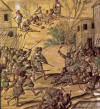 Pizzaro marches to Cuzco
Pizzaro marches to Cuzco
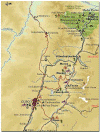 Cuzco
area
Cuzco
area
 Cuzco
today/ note Inca wall
Cuzco
today/ note Inca wall
Pizarro marched with 106 soldiers and 62 horsemen to Cajamarca where Atahualpa was resting with his army of 80,000. Atahualpa was confidant that his army could deal with less than 200 men. However, Pizarro recalling Cortes' capture of Motecuzuma hatched a similar plan to draw Atahualpa and his entourage of unarmed nobles into an ambush in the town square on Nov 16, 1532, while Atahualpa's army stayed on the hills surrounding the city. As Atahualpa came carried on a litter to meet with a priest envoy, Pizarro and his men sprang out from their concealed positions and massacred the nobles and captured Atahualpa. Since, Atahualpa was being held hostage the Incan generals backed off into the hills and the Spanish demanded gold and silver ransom. The ransom was to fill a room 7x5x3 meters once with gold and twice with silver. Supposedly, Atahualpa learned to play chess during the waiting for the loads of gold and silver ransom. The Inca complied but Pizarro decided to stage a mock trial with charges like idolatry and revolting against the Spanish. This seems odd since on the earlier contact with the envoy priest, Fr. Valverde, he did not read the requerimiento to submit to the Spanish Crown and the Catholic Church. However, Atahualpa was found guilty and sentenced to be executed by burning. This was against Incan religion and would cause the soul to not be able to travel to the afterlife and ultimately Fr. Valverde conceded to convert Atahualpa to Christianity so that he was executed by strangulation (garrote) on July 26, 1533, instead of burning. Atahualpa's brother, Inca Tupac Huallpa succeeded him as a puppet ruler and likewise another brother Manco Inca.
Pizarro and his men went on to after resupply made their way to Cusco where they discovered great quantities of gold and silver as the pillaged the capital city. Pizzaro found the mountainous capital difficult to resupply and eventually established Lima, Peru on the central coast in 1535. Pizarro and his old partners ended up quarreling over jurisdiction of the spoils of engaged in the Battle of Las Salinas in 1538 where Pizarro's old partner Almagro was executed. Later, Almagro's son exacted revenge and led a coup against Pizarro in his palace and assassinated him on June 26, 1541. Ironically, Atahualpa's sister Ines Yupanqui who had been 'given' to Pizarro married another Spaniard and took a daughter and went to Spain.
4. Smith and Wahunsenacawh
Along the Virginia coast and tributaries that flowed into the Chesapeake Bay,
a confederacy of Virginia Algonkians (30 groups) under the
leadership of Wahunsenacawh of the Powhatan. Wahunsenacawh (1545-1618) was
sometimes referred to as Powhatan and began unifying these groups around 1580.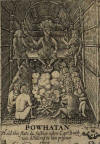
| Powhatan Confederacy 1580-1618 |
| Group | Leader/Capital Town | Location |
| Powhatan | Wahunsenacawh/Werowocomoco | York River |
| Arrohatecks | ||
| Appamatucks | ||
| Pamunkeys | Opechanacanough/ Youghtanund | |
| Mattaponis | ||
| Chiskiaks | ||
| Kecoughtans | ||
| Chickahominey (some autonomy) |
Captain John Smith (1580-1631) was an English soldier of fortune who shipped
off to sea at age 16. Smith had a long career as a mercenary in the Middle East
(Ottoman Empire) but returned to England and became involved in the Virginia
Company of London to encourage settlement along the Atlantic Seaboard.
 Smith
sailed with three ships commanded by Capt. Newport and landed at Cape Henry on
April 26, 1607. By May they chose a site they called Jamestown. By December the
situation was desperate and Smith was captured seeking food by Wahunsenacawh's
brother Opechanacanough to the capitol Werowocomoco. 'Legend' has it that
Wahunsenacawh's daughter, Pocahontas (Matoaka) (1595-1617) saved Smith form
being killed. However, this was something Smith wrote 17 years later and most
historians conclude that this was a fabrication.
Smith
sailed with three ships commanded by Capt. Newport and landed at Cape Henry on
April 26, 1607. By May they chose a site they called Jamestown. By December the
situation was desperate and Smith was captured seeking food by Wahunsenacawh's
brother Opechanacanough to the capitol Werowocomoco. 'Legend' has it that
Wahunsenacawh's daughter, Pocahontas (Matoaka) (1595-1617) saved Smith form
being killed. However, this was something Smith wrote 17 years later and most
historians conclude that this was a fabrication. What is more likely is that Wahunsenacawh tried to create an alliance with Smith
and the new settlement at Jamestown. The 'romance' between Smith and Pocahontas
is also unlikely. In 1608 Smith took Opechanacanough hostage and demanded food (
twenty tons of corn). These aggressive tactics to gain food led to an all out
war between the Powhatans and English colonists. Somehow Smith was
injured/burned by gunpowder and returned to England in 1609, never returning.
The war continued and in 1613 Pocahontas was captured by the English and held
for ransom of the release of English prisoners. Whether, Pocahontas wished to
remain with the English is unclear, but she eventually was baptized Rebecca and
married a widower named John Rolfe. Thus, Pocahontas became Rebecca Rolfe. She
had a son, Thomas Rolfe, born Jan 30 1615. In 1616 the Rolfes went to England as
propaganda to attract settlers to the still struggling Jamestown.
What is more likely is that Wahunsenacawh tried to create an alliance with Smith
and the new settlement at Jamestown. The 'romance' between Smith and Pocahontas
is also unlikely. In 1608 Smith took Opechanacanough hostage and demanded food (
twenty tons of corn). These aggressive tactics to gain food led to an all out
war between the Powhatans and English colonists. Somehow Smith was
injured/burned by gunpowder and returned to England in 1609, never returning.
The war continued and in 1613 Pocahontas was captured by the English and held
for ransom of the release of English prisoners. Whether, Pocahontas wished to
remain with the English is unclear, but she eventually was baptized Rebecca and
married a widower named John Rolfe. Thus, Pocahontas became Rebecca Rolfe. She
had a son, Thomas Rolfe, born Jan 30 1615. In 1616 the Rolfes went to England as
propaganda to attract settlers to the still struggling Jamestown.
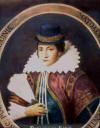 Pocahontas
was treated well in London and met James I and other members of the court.
Whether, she say Smith again is not clear and under what circumstances. In
March 1617 the Rolfes set sail but at Gravesend on the Thames River Pocahontas
became ill. She was taken ashore where she died (probably of a respiratory
infection) and she was buried as Rebecca Rolfe. Her son remained in London with
some Powhatan 'ladies in waiting'. John Rolfe returned to Virginia and became a
successful tobacco farmer. Wahunsenacawh also succumbed to disease in 1618 and
his younger brother, Opechanacanough became leader of the Powhatan.
Opechanacanough continued to war with the English in 1622 an 1644. John Rofe was
killed in 1622 against the Powhatan. Eventually, in 1644 Opechanacanough at 90
years of age was captured by the English and shot in the back. However, Thomas
Rolfe survived and returned to Virginia in 1632 and inherited land from his
father and uncle, Opechanacanough. Thomas with English and Powhatan is
recognized as one of the 'First Families of Virginia' with many tracing their
roots to Pocahontas and Wahunsenacawh. Those claiming descent are First Ladies
Edith Wilson (Pres. W. Wilson), Nancy Reagan (Pres. R. Reagan), George Wythe
Randolph, Gov. Harry Flood Boyd and Admiral Richard Byrd.
Pocahontas
was treated well in London and met James I and other members of the court.
Whether, she say Smith again is not clear and under what circumstances. In
March 1617 the Rolfes set sail but at Gravesend on the Thames River Pocahontas
became ill. She was taken ashore where she died (probably of a respiratory
infection) and she was buried as Rebecca Rolfe. Her son remained in London with
some Powhatan 'ladies in waiting'. John Rolfe returned to Virginia and became a
successful tobacco farmer. Wahunsenacawh also succumbed to disease in 1618 and
his younger brother, Opechanacanough became leader of the Powhatan.
Opechanacanough continued to war with the English in 1622 an 1644. John Rofe was
killed in 1622 against the Powhatan. Eventually, in 1644 Opechanacanough at 90
years of age was captured by the English and shot in the back. However, Thomas
Rolfe survived and returned to Virginia in 1632 and inherited land from his
father and uncle, Opechanacanough. Thomas with English and Powhatan is
recognized as one of the 'First Families of Virginia' with many tracing their
roots to Pocahontas and Wahunsenacawh. Those claiming descent are First Ladies
Edith Wilson (Pres. W. Wilson), Nancy Reagan (Pres. R. Reagan), George Wythe
Randolph, Gov. Harry Flood Boyd and Admiral Richard Byrd.
B. Conquest: God, Gold, Glory
1. Spanish Encomienda
As we have seen in the invasion of America Europeans created various
policies and decrees to justify conquest and subjugation. These were initiated
by the Spain and Portugal during the Crusades and invasion of Africa to justify
treatment of non-Christians and 'pagans'. The Doctrine of Discovery and
requiiemento were applicable to the New World as long as they were
'discovered' to be 'not be under dominion of Christian rulers'. Initially, the
Crown of Castile created a policy to grant protection and religious instruction
to Native Americans in exchange for labor and land use. This feudal system in
America was referred to as Encomienda System. In actually Spain was granting
Spanish colonists Indian labor and land as an economic incentive to benefit the
Council of the Indies which managed affairs for the Crown and Church in America.
Indians were to be clothed, feed, educated, and protected. In the Caribbean the
Spanish abused the entire program and the Indians died of diseases or starved to
death. Spain tried to modify the problem with legislation but failed to
change conditions. As Native Americans died at an alarming rate, African
slaves were brought in to replace the Indians for labor but were treated worse.
A one time priest in Cuba,
Bishop Bartolome de Las Casas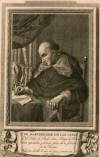 dedicated his work in
Spain to get the Crown in Castile to stop the mistreatment of Native Americans.
The publication of ...Brief history of the Destruction of the Indies in
1549 documents his own experiences and Las Casas estimated that 50 million
Native Americans died in the first fifty years of Spanish colonization.
dedicated his work in
Spain to get the Crown in Castile to stop the mistreatment of Native Americans.
The publication of ...Brief history of the Destruction of the Indies in
1549 documents his own experiences and Las Casas estimated that 50 million
Native Americans died in the first fifty years of Spanish colonization.
 A trial
ensued and Spain acknowledged the abuses, abolished slavery in the silver and
gold mines, but were unable to enforce change. In fact the Council of the Indies
softened the changes by just asking encomienda grantees to lower tribute and not
require personal services. Even these changes were virtually impossible to
enforce. As the Spanish expanded colonization to Meso America and South America
the encomienda system continued to operate, but the breakdown of Native American
populations and the increase of mestizos, who were not liable to encomienda
service caused the system to collapse. In some areas like Potosi, Bolivia the
abuse of the encomienda system was extreme. Mount El Cerro contain one of the
largest outcrops of silver in the world. In 1572 Spanish Viceroy Francisco de
Toledo implemented a forced labor policy, called 'la mita' that required all
Native American males between 18-50 to work in the mines in intermittent
periods. This resulted in a 80% death rate and required importing Native
Americans and African slaves. The silver produced (from just Potosi) at least
25% of Spain's revenue.
A trial
ensued and Spain acknowledged the abuses, abolished slavery in the silver and
gold mines, but were unable to enforce change. In fact the Council of the Indies
softened the changes by just asking encomienda grantees to lower tribute and not
require personal services. Even these changes were virtually impossible to
enforce. As the Spanish expanded colonization to Meso America and South America
the encomienda system continued to operate, but the breakdown of Native American
populations and the increase of mestizos, who were not liable to encomienda
service caused the system to collapse. In some areas like Potosi, Bolivia the
abuse of the encomienda system was extreme. Mount El Cerro contain one of the
largest outcrops of silver in the world. In 1572 Spanish Viceroy Francisco de
Toledo implemented a forced labor policy, called 'la mita' that required all
Native American males between 18-50 to work in the mines in intermittent
periods. This resulted in a 80% death rate and required importing Native
Americans and African slaves. The silver produced (from just Potosi) at least
25% of Spain's revenue.
 Today, Quechua still mine the area and chew coca leaves
to suppress hunger and altitude sickness. The city of Potosi is one of the most
depressed in Bolivia.
Today, Quechua still mine the area and chew coca leaves
to suppress hunger and altitude sickness. The city of Potosi is one of the most
depressed in Bolivia.
 Many want to make El Cerro a World Heritage Site, but
recent assays indicate the there is a lot more silver.
Many want to make El Cerro a World Heritage Site, but
recent assays indicate the there is a lot more silver.
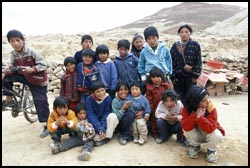 children mine workers at Potosi today
children mine workers at Potosi today
Silver and gold mines were also exploited in Southern Mexico and provided more revenue after Potosi was played out. The Spanish Crown received their royal fifth plus, taxes and profit on the sale mercury needed to more efficiently process the ores.
Since Spanish conquistadors were not satisfied with Meso and South America, expeditions were launched into North America. The expeditions of DeSoto (1539), Coronado (1540) and Cabrillo (1542) initiated expansion into the 'Northern Frontier'. The colonial expansion and encomienda began at St. Augustine, Florida (1565) and Sante Fe, New Mexico (1598). In Florida missions extended up into the panhandle with a settlement and presidio at Pensacola. Sante Fe was the first settlement but the Spanish established missions within the Native American Pueblos. At first the Indian Pueblo of San Juan was the capitol but by 1608 Sante Fe became the Spanish colonial capitol. Later, in 1769 the Spanish finally began to colonize California with the beginnings at San Diego, with 21 missions stretching out to just north of San Francisco at San Rafael. The pueblos at San Diego, Los Angeles, Monterey and San Jose were the colonial outposts in the west.
 Castillo,
St. Augustine, FL Castillo,
St. Augustine, FL |
 Santa
Fe, NM Santa
Fe, NM |
 Old
Town, San Diego, CA Old
Town, San Diego, CA |
2. English Capitalism and Puritanism
Given that Spain had received authority from the Pope in Rome and had
produced contrived decrees of Doctrines of Discovery, England and France were
left with the crumbs. Eventually, they went to war with Spain. Initially, they
probed the Spanish by financing 'privateers' (pirates) to raid Spanish ports and
ships in America. For England this began with Queen Elizabeth I (ERI) sending
her 'sea dogs' like Sir Frances Drake and Sir Walter Raleigh to prey upon the
Spanish in the mid 1500s. Not only were they successful in pillaging Indian
silver and gold, they also brought back valuable intelligence on the weaknesses
of the Spanish Armada.. After the English under ERI defeated the Spanish in
1588, her successor James I formed the Virginia Company as capitalistic
enterprise to find gold and riches in America. The first settlers established
Jamestown in 1607, but as we have already seen Jamestown failed at many levels.
No gold was found nor a Northwest passage to China. Only later did new colonists
with better agrarian skills stumble (with the help of Pocahontas) upon a cash
crop, tobacco. By 1619 50,000 lbs. of cured tobacco was shipped annually
to England. James I early on found tobacco to be 'loathsome' and harmful, but
the fad (addiction) had taken hold in England. Also, in 1619, twenty African
slaves were brought to Jamestown to work on the eleven plantations. However,
epidemics and war with the Powhatan took their toll and the colonists at
Jamestown suffered a 60% loss of life. As a result James I revoked the Virginia
Company's charter in 1624 and put the colony under direct royal administration.
Much of the failure was placed on the Virginia Company for dumping ill prepared
new settlers with little food or provisions. Thus, one of the first capitalistic
enterprises was a failure and had to be bailed out by the government.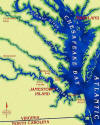
One group of replacement colonists bound for Jamestown were Separatists
(Puritans) from the Church of England. Initially they escaped England and sought
refuge in the United Netherlands (Holland). Later these puritans were provided
free passage to Jamestown by the Virginia Company and decided to leave Holland.
In 1620 when they sailed on the Mayflower, they were blown off course and landed
at Plymouth. The Puritans on board this ship called themselves Pilgrims.. Since
other Europeans had sought refuge at Plymouth, since it was a protected harbor
by Cape Cod, disease had impacted the Native American people of the area. This
was noted by the Puritan/English as being sign of their destiny under God to
settle the land unimpeded. Since they were out of the jurisdiction the Plymouth
settlers decided organize a democracy under Puritan code. The first winter was
hard and the initial Mayflower group lost half of their numbers by Spring of
1621. The surviving Wampanoag Native Americans and their leader (sachem),
Massasoit saw an opportunity for an alliance with the English to deal with
neighboring enemy groups and sent two English speaking emissaries to negotiate.
One of these was Squanto (Tisquantum) who had been captured and sold into
slavery only to gain passage back to Plymouth and find his people at Patuxet
wiped out by an epidemic.
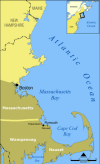 Squanto stayed with the Plymouth colonists and taught
them how to plant CBS, fish and hunt. In the Fall in the Native American
tradition of giving thanks with Massasoit and many Wampanoag feasting with the
Pilgrims on Nov 21, 1621. This of course has become a uniquely American holiday,
Thanksgiving.
Squanto stayed with the Plymouth colonists and taught
them how to plant CBS, fish and hunt. In the Fall in the Native American
tradition of giving thanks with Massasoit and many Wampanoag feasting with the
Pilgrims on Nov 21, 1621. This of course has become a uniquely American holiday,
Thanksgiving.
More Puritans and other English came and expanded into new settlements at
Wollaston, Duxbury, and Weymouth. When settlers resorted to stealing from
surrounding Native American village storage caches, the Indian sachems (leaders)
cut off trade and support. Miles Standish led a raid against a Massachusett
tribal sachem, Wituwamet, and cut off his head as a war trophy. many of the
colonist problems were blamed on the in ability to maintain a system of communal
sharing, so land was divided into specific plots and put up for sale. When
Charles I succeeded James I, he established a new enterprise/investment group
called the Massachusetts Bay Company and sponsored 1000 new settlers to the
colony. As smallpox continued to decimate Native American groups the new
governor of the colony, John Winthrop saw disease as an act of God again in
favor of the colonists, Manifest Destiny. As colonists moved south and west into
Massachusetts and Connecticut they ran into new Native American groups like the
Narragansett Mohegan, and Pequot. Small squabbles and violence erupted into all
out war called the Pequot War 1633-1637, which ended in the controversial Mystic
Massacre (1637).
 Some
600 Pequot, mostly women and children were surrounded and massacred. Even allied
Indian groups at the large scale slaughter by Puritan colonists. The Pequot were
subjected to all out genocide, even with their name being eradicated from
written records. Other English separatist colonies like Rhode Island were
splinter groups or new colonies started like Maryland which was established for
English Catholics.
Some
600 Pequot, mostly women and children were surrounded and massacred. Even allied
Indian groups at the large scale slaughter by Puritan colonists. The Pequot were
subjected to all out genocide, even with their name being eradicated from
written records. Other English separatist colonies like Rhode Island were
splinter groups or new colonies started like Maryland which was established for
English Catholics.
In 1675-1676 conflict in the north erupted again between Puritans and surviving Wampanoag under the leadership of Massasoit's son Meacomet or King Philip. Pressure from Puritans to gain new land and convert Native Americans into 'praying towns' brought King Philip to the conclusion that he must resist. He allied with neighboring tribes and engaged in a rather bloody war that claimed the lives of 3000 Native Americans and 600 colonists (these numbers are contested). The English in the end had better firepower and King Philip was hunted down and killed in 1676. Surviving leaders were executed and most captives were sold into slavery for New England homes or the markets in the West Indies.
The English continued to expand along the Eastern Seaboard with the Quaker,
William Penn negotiating with the Delaware (Leni Lenape) for land to sell to
Pennsylvania Dutch and Scot Irish settlers beginning in 1683. In 1663 Charles II
created the Carolina Charter the was the impetus to settle North and South Carolina.
the was the impetus to settle North and South Carolina.
The English in New England developed small farms under the religious and work ethic of a Puritan code. Gentry English settlers in Virginia and the Carolinas acquired larger plots of land that required greater labor in the form of African slaves to replace the rapidly dying Native American slaves. Georgia was a penal colony but eventually adopted the large plantation pattern. The English settlement of Barbados connected trade of slaves, tobacco, hides, sugar and rice at the port of Charleston, South Carolina. In New England whaling and early industrial plants emerged as important exports. The English did not use Native American labor to the degree that the Spanish did, nor did they try to integrate Native Americans openly. They separated themselves from Native peoples by first removing (1830>) all surviving Eastern Woodland Native Americans west of the Mississippi to Oklahoma. Once removed the Native Americans were relegated to reservations in Oklahoma and all of the West. In some cases the reservation included traditional land in other cases the particular group was moved to non traditional land often far away.
3. French Fur and Sugar
After initial explorations of the St. Lawrence
_small.jpg) by
Jacques Cartier in the 1530s and Samuel de Champlain's surveying in the neaerl6y
1600s, Champlain
founded Quebec in 1608. Later, Sieur of Laviolette established Trois-Rivieres as
another strategic outpost along the St. Lawrence. In Cartier's interaction with
Iroquois-Huron people he heard a word for 'village', kanata,
which he thought to mean the country and people thus we got the word Canada and
Canadians for both Native Americans and colonists. The French also used the term
'New France', which rapidly went beyond Canada as the beaver fur trade
by
Jacques Cartier in the 1530s and Samuel de Champlain's surveying in the neaerl6y
1600s, Champlain
founded Quebec in 1608. Later, Sieur of Laviolette established Trois-Rivieres as
another strategic outpost along the St. Lawrence. In Cartier's interaction with
Iroquois-Huron people he heard a word for 'village', kanata,
which he thought to mean the country and people thus we got the word Canada and
Canadians for both Native Americans and colonists. The French also used the term
'New France', which rapidly went beyond Canada as the beaver fur trade
 expanded
and beaver 'felt' hats
expanded
and beaver 'felt' hats
 added
to the demand. The relationships with the Iroquois deteriorated and French tended
to ally themselves with the Algonquin people and Huron. Initial fur trade was
controlled by Cardinal Richelieu (1585-1642) under a group of investors,
Compagnie des Cent Associes, trading with Indians and French called coureur des
bois (runner of the woods). Missionaries, like the Jesuits, were supposed to
civilize the Indians to enhance trade alliances. However, both the coureur des
bois and Jesuits did not abide by the wishes of the government in France. The
coureur des bois often married Native Americans and lived with and as Native
American. Later, these people became known as Metis. The government tried to
control them by issuing limited permits and those with permits became known as
'voyageur' (traveler). With the many lakes and interconnecting rivers travel was
by canoe between 'rendezvous posts' like Grand Portage, MN on Lake Superior
added
to the demand. The relationships with the Iroquois deteriorated and French tended
to ally themselves with the Algonquin people and Huron. Initial fur trade was
controlled by Cardinal Richelieu (1585-1642) under a group of investors,
Compagnie des Cent Associes, trading with Indians and French called coureur des
bois (runner of the woods). Missionaries, like the Jesuits, were supposed to
civilize the Indians to enhance trade alliances. However, both the coureur des
bois and Jesuits did not abide by the wishes of the government in France. The
coureur des bois often married Native Americans and lived with and as Native
American. Later, these people became known as Metis. The government tried to
control them by issuing limited permits and those with permits became known as
'voyageur' (traveler). With the many lakes and interconnecting rivers travel was
by canoe between 'rendezvous posts' like Grand Portage, MN on Lake Superior
![]() where
goods were traded for fur and then shipped to Montreal that was a processing and
trading post.
where
goods were traded for fur and then shipped to Montreal that was a processing and
trading post.
 Birch
Bark canoe Construction Birch
Bark canoe Construction |
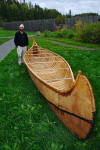 Finished
Canoe Finished
Canoe |
 Grand
Portage Grand
Portage |
 Fur Fur |
The Jesuits (called Black Robes) came to Canada in 1611 worked with the
Montagnais, Algonquin and Hurons. They tended to be an independent communal
order that did not always agree with government demands. The Native Americans
found the Jesuits to be inflexible and responsible for the epidemics that
decimated the people. To achieve in roads in Native American culture the Jesuits
learned Native American culture and language, which they recorded in letters to
their headquarters called the Jesuit Relations (1616-1672). These
letters in the 'JR' have provided early ethnographic information on Native
American groups that have since been decimated.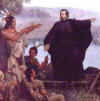 Father Marquette and Joliet expanded French interests down the Mississippi River
to New Orleans. This addition referred to as Louisiana, connected trade to
the West Indies in Haiti and Saint Kitts to South America in French Guiana. As
France expanded in the West Indies (Caribbean) with colonies in Guadalupe,
Martinique and Saint Lucia; sugar became the most important commodity in the
tropics. In the West Indies African slaves were exploited since the Native
American population had been reduced by over 90%. This was France's First
Colonial Empire (1608-1830). The conflict for most of empire was between
England, Spain and France. At the end in the 18th century much of the conflict
for North America was between England and France. It was out of these conflicts
that emerged the United States.
Father Marquette and Joliet expanded French interests down the Mississippi River
to New Orleans. This addition referred to as Louisiana, connected trade to
the West Indies in Haiti and Saint Kitts to South America in French Guiana. As
France expanded in the West Indies (Caribbean) with colonies in Guadalupe,
Martinique and Saint Lucia; sugar became the most important commodity in the
tropics. In the West Indies African slaves were exploited since the Native
American population had been reduced by over 90%. This was France's First
Colonial Empire (1608-1830). The conflict for most of empire was between
England, Spain and France. At the end in the 18th century much of the conflict
for North America was between England and France. It was out of these conflicts
that emerged the United States.
| English and French Colonial Conflicts |
| War: North American (European) | Dates | Native Americans | Results |
| King William's War (War of the Grand Alliance) | 1689-1697 | Treaty of Ryswick | |
| Queen Anne's War (War of Spanish Succession) | 1702-1713 | Treaty of Utrecht | |
| King George's War (War of Austrian Succession) | 1744-1748 | Treaty of Aix-la-Chapelle | |
| The French and Indian War (Seven Years' War) | 1754-1763 | Fr: Algonquin, Huron/Eng. : Iroquois | Treaty of Paris |
| War of the American Revolution | 1778-1783 | ||
| French Revolution | 1793-1802 | ||
| War of 1812 (Napoleonic Wars) | 1803-1815 | ||
4. Dutch Trade
The Netherlands (Dutch) were primarily traders in the New World and initially
established the United East India Company (VOC) and in 1609 hired the English
navigator, Henry Hudson to find a Northwest passage to Asia. Hudson explored the
Atlantic Coast including New York Harbor's Staten and Manhattan Islands. On a
second voyage Hudson went north and found Hudson's Bay but the harsh conditions
resulted in a mutiny and Henry Hudson disappeared. In 1621 the West India
Company (WIC) was formed to manage trade in America. In 1626 Pieter Minuit
negotiated for the purchase of Manhattan Island from a group of Wappinger
Indians for 60 guilders (~$24). Minuit and a number of the settlers were really
French/Belgium Protestants (Huguenots or Walloons). They established a colony
known as New Amsterdam. The Indians assumed they still had use rights but were
harassed and pushed out. They built a fort at Ft. Neck on Long Island. Gov.
Stuyvesant hired a soldier/mercenary John Underhill to deal with his Indian
problem. Underhill had married a Dutch woman and moved from Massachusetts Bay
Colony to New Amsterdam. Underhill was one of the leaders of the Mystic Massacre
against the Pequots in 1637. Underhill attacked the Massapequa's Ft. Neck
and killed over 120 men, women and children. Conflict also arose between the
English and Dutch over trading rights and Indian alliances. New Amsterdam's
Governor Peter Stuyvesant built a fortified wall (today's Wall Street) across
the bottom of Manhattan Island. however, war was averted. Trade with wampum
beads became common place along the Atlantic Seaboard and the Dutch continued to
provide guns, silver and swords. Eventually, the English threatened again with a
contingent of warships in 1664 and Stuyvesant, although furious, opted for
surrender and New Amsterdam became New York.
became common place along the Atlantic Seaboard and the Dutch continued to
provide guns, silver and swords. Eventually, the English threatened again with a
contingent of warships in 1664 and Stuyvesant, although furious, opted for
surrender and New Amsterdam became New York.
The end of the 18th century brought great changes in Europe and Colonial America, principally with the United States followed by nation building continuing into the 19th century throughout the America's. Thus Native Americans would deal with specific governments shaped in the New World. In some cases Native Americans played substantial roles in the emergence of these nations, in others there were few Native American left or their role in the country was minimal.
C. Rebellion
[Note: In many books on history of the Americas rebellion is the least covered or downplayed because as the founding premise to many of the American colonial nations it is uncomfortable or inconvenient to note the Native American rebellion of unjust treatment by the European Americans that rebelled against their Old World European governments. Often Native Americans were portrayed as invisible or submissive. The different attitudes about land use and ownership, the language of treaties and the lack of adherence to policy in a frontier atmosphere led to continuous conflict in all phases of invasion and conquest. Disease took such a terrible toll and proved to be the European's secret weapon. In all the conflicts and wars Native American's sought spiritual guidance to provide motivation and power. It could be argued that liberty and rebellion are more of a Native American idea. So it is quite embarrassing for European Americans to admit that they not only stole land and resources, but the ideas behind their democratic nations.]
1. Pueblo Revolt 1680
When Spain expanded into the North American frontiers like the Southwest in
1598, some new pueblos like Santa Fe were established, but many mission churches
were placed directly in Indian pueblos. This may have been because of the
permanence of these Indian pueblos like Taos and the fact that their total
destruction would have been rather obvious. These city-state Native American pueblos numbered 60-70 at the time the Spanish
but were reduced to ~ 19. The Spanish exacted the encomienda system to build
missions, Hispanic pueblos and individual ranches.
These city-state Native American pueblos numbered 60-70 at the time the Spanish
but were reduced to ~ 19. The Spanish exacted the encomienda system to build
missions, Hispanic pueblos and individual ranches.
| Today's Southwest Indian Pueblos |
| Acoma | Keresan | |
| Laguna | Keresan | |
| Santa Ana | Keresan | |
| Zia | Keresan | Zia symbol on New Mexico state flag |
| Cochiti | Keresan | |
| Santo Domingo | Keresan | |
| San Felipe | Keresan | |
| Jemez | Tanoan: Towa | |
| San Juan | Tanoan: Tewa | 2005 Ohkay Owingeyh Pueblo; base of Pueblo Revolt 1680; N. Pueblo Council |
| San Ildefonso | Tanoan: Tewa | |
| Santa Clara | Tanoan: Tewa | |
| Tesuque | Tanoan: Tewa | |
| Nambe | Tanoan: Tewa | |
| Pojoaque | Tanoan: Tewa | reestablished 1930s |
| Taos | Tanoan: Tiwa | |
| Picuris | Tanoan: Tiwa | |
| Sandia | Tanoan: Tiwa | |
| Isleta | Tanoan: Tiwa | |
| Zuni orig 7 villages/ 3 today | Zuni | |
| Hopi 5-8 villages | Uto-Aztecan/Shoshonean | 3 Mesas, Hano is a Tewa refugee village from the Pueblo Revolt |
Since Spanish priests were so immersed within the traditional Indian pueblos
conflict over religion intensified. Priests were insistent that Pueblo people
convert and destroyed traditional centers of worship called kivas. Sacramental
objects like masks and kachinas were burned. Those that resisted, including
traditional holy men were seen as subversive or criminals and were imprisoned,
flogged, tortured and executed. Major uprisings such as at Acoma in 1598
resulted in burning the pueblo and pushing many off the cliff. Survivors were
punished with; males over 25 got one foot amputated and 20 years labor; males
12-25 got twenty years and females 12+ got twenty years. In 1630 Fr. Dominguez
reported about 60 missionaries in walled compounds within the Indian
Pueblos, but the number dwindled to 33 by 1680. Early rebellions gave
information about the strength and weaknesses of the Spanish. A San Juan Pueblo
medicine man named Pope (Popay) may have organized the Pueblo Revolt of 1680.
Popay and others had been identified as conspirators against Spanish rule and
were publically flogged. In the summer of 1680 Popay
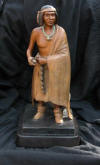 established a base at Taos
Pueblo and sent runners
established a base at Taos
Pueblo and sent runners with knotted cords to verify an alert to all the Indian
Pueblos including the Hopi towns 300 miles west.. The first messengers were captured and
new runners went out with a message to move the rebellion from Aug 11 to Aug 10,
1680. At dawn most of the Indian pueblos struck and killed 21 missionaries (they
had been warned and asked to leave) out of 33. Over 2500 Indians attacked Santa
Fe with 300 settlers/ colonists killed. Many fled into Texas, but some Mexican
Indians and mixed blood (mestizo) stay in New Mexico. For 12 years the Pueblos
resisted reconquest. Between 1692 and 1696 the Spanish returned under Don Diego
de Vargas. De Vargas retook Santa Fe and promised peace. Once Pueblo leaders
relinquished power de Vargas executed Pueblo leaders and enslaved their
families. On June 4, 1696 a second revolt occurred but it was rather
unsuccessful. Many refugees hid out in Navajo and Hopi land where the Spanish
never reestablished missions. The Spanish became less insistent on total
conversion and actually needed each other for protection from increasing raids
from Navajo, Ute and Apache groups. A number of Pueblos were abandoned before
and during the reconquest. Many refugees settled into present day Jemez Pueblo.
with knotted cords to verify an alert to all the Indian
Pueblos including the Hopi towns 300 miles west.. The first messengers were captured and
new runners went out with a message to move the rebellion from Aug 11 to Aug 10,
1680. At dawn most of the Indian pueblos struck and killed 21 missionaries (they
had been warned and asked to leave) out of 33. Over 2500 Indians attacked Santa
Fe with 300 settlers/ colonists killed. Many fled into Texas, but some Mexican
Indians and mixed blood (mestizo) stay in New Mexico. For 12 years the Pueblos
resisted reconquest. Between 1692 and 1696 the Spanish returned under Don Diego
de Vargas. De Vargas retook Santa Fe and promised peace. Once Pueblo leaders
relinquished power de Vargas executed Pueblo leaders and enslaved their
families. On June 4, 1696 a second revolt occurred but it was rather
unsuccessful. Many refugees hid out in Navajo and Hopi land where the Spanish
never reestablished missions. The Spanish became less insistent on total
conversion and actually needed each other for protection from increasing raids
from Navajo, Ute and Apache groups. A number of Pueblos were abandoned before
and during the reconquest. Many refugees settled into present day Jemez Pueblo.
2. Jesuit Missions and Guarani 1750
The Guarani (Warani) are a large linguistic group of Tupi-Guarani speakers
from Southern Brazil, Uruguay, Paraguay and Argentina. The Guarani proper lived
along the Paraguay River and its branches mostly in present day Paraguay.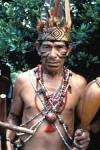 They
were traditionally sedentary farmers of CBS and manioc living in large palisaded
villages. Pre-contact population estimates are at 400,000 or more.
They
were traditionally sedentary farmers of CBS and manioc living in large palisaded
villages. Pre-contact population estimates are at 400,000 or more.
The Spanish first explored the outflow of the Parana/Paraguay River at the
Rio de plata in 1511. In 1537 Gonzalo de Mendoza founded Asuncion (later the
capitol) and imposed a policy of enslavement of the Guarani. When Jesuit priests
and monks arrived in 1585 they offered the Guarani protection from slavery in
return for conversion. In 1608 King Philip III of Spain gave royal authority to
the Jesuits for encomienda that overruled earlier Franciscan missionary
jurisdiction. To the east in Sao Paulo, Brazil there was a bustling port of
slave traders, many of Portuguese, African and Indian descent called Paulistas.
For over 100 years the Paulistas, unchallenged, launched slave hunting
expeditions called 'bandeiras'. Initially they had taken more than 1
million Indian slaves from the coastal regions of Brazil and they began sending
banderias into the western interior along the Paraguayan borders. The Jesuits
had built 12 missions on the lower part of the Paraguay River and were sending
missionaries above the falls to build 3 more missions. Between 1629-1631
Portuguese Paulista armies attacked and burned the upper missions and carried
off 60,000 Christian Guarani to be sold into slavery. In this turmoil the
Jesuits began to arm the Guarani and formed a defense force for the existing
missions. In 1641 Christian Guarani defeated an army of 800 Paulista on the
Aracay River. The Jesuits and Guarani built new missions (29) and increased
their defense forces to 7,000 Guarani. Also, new missions were built and some peace came to the missions. In 1732 there were 32 missions
and 141,000 Christian Guarani. In 1734 the first of a number of smallpox
epidemics struck. In 1750 the boundaries between Spain and Portugal put some of
the upper missions in Portuguese territory and the Guarani refused to leave,
which erupted into a guerilla war for 7 years and the destruction of 7 missions.
The Jesuits got a royal decree annulling the boundary and restoring some of the
missions.

In 1767 King Charles III of Spain issued a royal edict to expel the Jesuit
order from all Spanish dominions to develop revenue to tax all converts. This is
referred to as the Jesuit Reductions. Although an army moved into the existing
Jesuit missions with an army of over 144,000 Guarani, the Jesuits just left and
Franciscan took their place. However, the Guarani found that they lost
considerable freedom under the Franciscans and thousands of Guarani returned to
the forest or drifted into towns. By 1848 the missions were gone, unoccupied.
![]() However,
the Guarani still make up a great deal of the population of Paraguay and the
social language of Paraguay is Guarani.
However,
the Guarani still make up a great deal of the population of Paraguay and the
social language of Paraguay is Guarani.
NOTE: The 1986 film, "The Mission"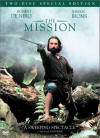 with Robert DeNiro, Jeremy Irons and Liam Neeson depicts the Guarani mission
story around 1750 when the boundaries changed and the Battle of Mbobore, when
Guarani actually defeated the Paulista. People and events are combined or
compressed but the film gives a vivid account of the conflict between what the
Jesuits , Guarani and the Paulistas. The music won most of the awards and
combines European and Native American music. The Native Americans are mostly
from Venezuela.
with Robert DeNiro, Jeremy Irons and Liam Neeson depicts the Guarani mission
story around 1750 when the boundaries changed and the Battle of Mbobore, when
Guarani actually defeated the Paulista. People and events are combined or
compressed but the film gives a vivid account of the conflict between what the
Jesuits , Guarani and the Paulistas. The music won most of the awards and
combines European and Native American music. The Native Americans are mostly
from Venezuela.
3. Pontiac's Rebellion
The Indian War of 1763-1766 is often referred
to as Pontiac's War or Pontiac's Conspiracy, but today scholars see this
conflict of much more dispersed throughout the Old Northwest and not a unified
action controlled by the Ottawa leader Pontiac.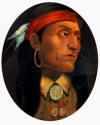 The Old Northwest was centered
on the Ohio River Valley and the British and French had just ended a serious of
conflicts with the French and Indian Wars (Seven Years War) of 1754-1763. These
frontier regions of this colonial period were in turmoil with unsettled trade
alliances between Native American groups caught between British and French
attempts at swaying Native American loyalty. British troops and militia had
treated all Native American groups with a heavy hand and outright cruelty.
Native American groups were capable of violent and cruel acts, but British
troops under General Jeffrey Amherst
The Old Northwest was centered
on the Ohio River Valley and the British and French had just ended a serious of
conflicts with the French and Indian Wars (Seven Years War) of 1754-1763. These
frontier regions of this colonial period were in turmoil with unsettled trade
alliances between Native American groups caught between British and French
attempts at swaying Native American loyalty. British troops and militia had
treated all Native American groups with a heavy hand and outright cruelty.
Native American groups were capable of violent and cruel acts, but British
troops under General Jeffrey Amherst
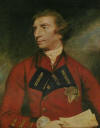 had acted in pure revenge by destroying
entire unoffending villages of 'Christian' Indians. After the French and Indian
Wars colonial settlers expected lands to open up including land pensions to
veterans or survivors. The British tried to control the post war land grab via a
Royal Proclamation of 1763 that created a boundary between colonists and Native
Americans. Gen. Amherst cut the payments promised to loyal Native Americans and
ordered traders to cut off supplies of ammo and powder. Gen. Amherst and his
officers at various frontier outposts like Ft. Detroit treated the Native
Americans with open contempt and ridicule.
had acted in pure revenge by destroying
entire unoffending villages of 'Christian' Indians. After the French and Indian
Wars colonial settlers expected lands to open up including land pensions to
veterans or survivors. The British tried to control the post war land grab via a
Royal Proclamation of 1763 that created a boundary between colonists and Native
Americans. Gen. Amherst cut the payments promised to loyal Native Americans and
ordered traders to cut off supplies of ammo and powder. Gen. Amherst and his
officers at various frontier outposts like Ft. Detroit treated the Native
Americans with open contempt and ridicule.
 Ft.
Detroit
Ft.
Detroit
 Siege
At Ft. Detroit
Siege
At Ft. Detroit
This shift of power and colonial expansion was compounded by increased food shortages and epidemics. An influential Native America religious leader, known as Neolin, the Delaware Prophet, began to preach an anti-European sentiment that spread to many tribes in the Old Northwest. The Delaware Prophet revealed that in a vision the Master of life was displeased with the people for becoming dependent on European trade goods and alcohol peddled by unscrupulous white trades. Neolin further warned that continued dependency would bring destruction and death. Part of the scare was well founded with the spread of epidemic diseases like smallpox. In the Old Northwest these tribe/nations had formed confederacies for military and trading power and included the Great lakes Confederacy (Ottawa, Ojibwa, Potawatomi), the Illinois Confederacy ( ) and the Shawnee Confederacy (Shawnee, Miami, Delaware). Other refugee groups like the Mingo (Iroquois who broke away to Ohio) were influenced by the Delaware Prophet, Neolin. However, these groups could never fully unify and make up their mind whether to support the new British authority or hope that French power might be restored. The French were less patronizing and paid better in trade goods. As conditions deteriorated and unrest grew, many groups sent out War Belts (Wampum) to the various groups.
War officially began when Pontiac of the Ottawa
led an attack on Ft. Detroit and began a drawn out siege. Eight other British
forts were attacked over a two month period. Many scholars are not sure this was
a coordinated conspiracy on the part of Pontiac or even the French. Initially at
Ft. Detroit the British tried to drive the warriors of the Great Lakes
Confederacy away from the siege of Ft. Detroit but were defeated at the Battle
of Bloody Run on July 31, 1763. Some were burned with considerable loss of
life of settlers, soldiers and traders, as well as captives taken. At Ft. Miami
(near Ft. Wayne, IN) on May 27, 1763 the fort's British commander was lured out
of the forts gate by his Indian mistress and killed by Miami warriors. At Ft.
Ouiatenora (Lafayette, IN) local Indians were more friendly with the
British garrison and announced that they were obligated to take the fort and
capture the British forces, but did not harm them. At Ft. Pitt the Indians
surrounded the fort but could not assault the walls successfully and engaged in
a siege to cut off supplies. General Amherst sent a relief expedition and
suggested to the expedition's commanding officer that he might use
smallpox contaminated blankets to weaken the Delaware warriors. It turns out
that the British officers in the fort already had tried to give a Delaware
negotiation party contaminated blankets. Historical evidence indicates that the
attempt may no have worked since the Delaware party did not come down with
Smallpox. However, smallpox may have infected other Indian villages from a
different vector. The relief column was intercepted at the Battle of Bushy Run
on Aug. 5, 1763 and suffered heavy losses, but managed to get through to Ft.
Pitt.
 In the north at Ft. Niagara 300 Seneca, Ottawa and Ojibwa attacked a
column with supplies along the Niagara Falls portage and defeated a relief
force from the fort. This engagement is called the " Devil's Hole Massacre" and
more than 70 British soldiers and teamsters were killed. Such defeats led
frontier areas to feel unprotected and respond with vigilantism. In western
Pennsylvania a group of vigilantes from Paxton, PA marched into a 'Christian
Indian" village of Susquehannocks in Dec 1763 and murdered six people. Not
satisfied these vigilantes, called the Paxton Boys, drummed up more followers
and marched into Lancaster, PA to find 14 more Susquehannocks held in jail for
protection. The Paxton Boys broke into the jail all killed all the unarmed
Susquehannocks. They then went into Philadelphia looking for more Indians that
sought refuge in the city. This time a militia organized by Benjamin Franklin
stopped the group , but no charges were brought against the Paxton Boys.
In the north at Ft. Niagara 300 Seneca, Ottawa and Ojibwa attacked a
column with supplies along the Niagara Falls portage and defeated a relief
force from the fort. This engagement is called the " Devil's Hole Massacre" and
more than 70 British soldiers and teamsters were killed. Such defeats led
frontier areas to feel unprotected and respond with vigilantism. In western
Pennsylvania a group of vigilantes from Paxton, PA marched into a 'Christian
Indian" village of Susquehannocks in Dec 1763 and murdered six people. Not
satisfied these vigilantes, called the Paxton Boys, drummed up more followers
and marched into Lancaster, PA to find 14 more Susquehannocks held in jail for
protection. The Paxton Boys broke into the jail all killed all the unarmed
Susquehannocks. They then went into Philadelphia looking for more Indians that
sought refuge in the city. This time a militia organized by Benjamin Franklin
stopped the group , but no charges were brought against the Paxton Boys.
By Spring of 1764 Gen. Amherst was replaced by
Gen. Gage. Indian raids continued, so the bounty for Indian scalps was levied
again for all Indians over the age of 10. Gage sent punishing expeditions into
the Old Northwest and tried to negotiate unauthorized treaties. When Col.
Bradstreet came into Ft. Detroit , Pontiac had sent a peace wampum belt but
Bradstreet chopped the belt up to discredit Pontiac. This muddled the
effectiveness of these expeditions and caused many of the tribes, that were
ready to negotiate, to hesitate and ultimately dragged out the conflict. It was
not until the summer of 1765 that various tribes decided to negotiate for peace
and ironically Pontiac emerged as the primary negotiator. After a number of
preliminary meetings, Pontiac and other tribal representatives from the
Ottawa, Potawatomi, Wyandot, Ojibwa, Miami, Kickapoo and Mascouten attended. A
wampum shell
peace belt
 was presented with this statement:
was presented with this statement:
"We tell you now the French never conquered us neither did they purchase a foot of our Country, nor have they the right to give it to you.
We gave them liberty to settle for which they always rewarded us and treated us with great civility while there had it in their power,
but as they are become now your people, if you expect to keep these posts, we will expect to have proper returns from you."
The British never acknowledged this difference in perception of land tenure, nor did they even pay for the use of the land. Pontiac was never an overall leader of the Native American forces, but he helped end it. This confusing and muddled conflict had been costly with 400 soldiers killed and 2000 settlers killed and captured. Native American casualties may have been around 500 killed and captured, 5-6,000 deaths occurred due to European diseases.
Unfortunately Pontiac's War reinforced the British idea of segregation between colonists and Native people that was so much a part of the entire British Empire. Certain land rights were recognized, but frontier colonists began to resent denial of Western frontier lands which stimulated eventual unrest that led to the American Revolution.
4. The Ghost Dance and Wounded Knee
In the American West the Oklahoma/ Indian Territory quickly ran out of room for the Eastern and Prairie Native American groups relocated there. California had reservations established early but the reservations were never made official and ratified by congress due to Anglo land owners wanting all the land for themselves. Southern California Indians languished in some kind of limbo and were ignored by the government. After the Civil War many settlers poured into the West as railroads sped up settlement due to a federal bailout for rail tycoons giving them free land to sell to new immigrants. This influx of settlers coupled with the depletion of game especially the American Bison, led to the many wars of the West after 1866. Initially the US Army found the mounted Plans warriors to be superior fighters than the mostly green immigrant troopers of the Western postings. So commanders put into place a policy of extermination of the Plain's cultures food base the American Bison. The American Bison was 60 million strong in the early 1800s, but by 1880 it was virtually extinct (~1400 head). Once the Plains people were relegated to reservations on unwanted lands they starved to death mostly due to corrupt Indian Agents. Children were sent to boarding schools where they were beaten for speaking traditional language, had there hair cut and were taught menial jobs like housekeeping and ditch digging. As the corrupt Indian Agents were replaced by missionaries the Western tribes faced cultural extinction. Although Christianity was dominant some traditions were combined with the Christian teachings into new forms.
In Western Nevada around 1870 a Paiute holy
man had a vision that dictated that performing certain songs would bring the
Messiah who would bless the righteous, return the traditional ways, and
swallow up evil people. This movement was the 1st Ghost Dance and spread west to
California and Oregon. Ten years later in the 1880s another Paiute, Wovoka,
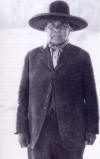 was
influenced by Tavibo, and had a vision in which songs and righteous behavior
would bring a return of the Messiah, Jesus, and that evil Whites would be
swallowed up and that deceased ancestors would return to the earth. These
teachings were learned about by Plains people and they sent a delegation by
train to Nevada to learns the songs This delegation included the Lakota leaders
Short Bull and kicking Bear. When they returned many Lakota (Western Sioux),
Arapaho, and Cheyenne adopted Wavoka's songs and invented new ones. People sang
and danced until they passed out. Some embellished the songs with Ghost Shirts
that were reputed to be bullet proof. Many leaders like Sitting Bull and Red
Cloud doubted the effectiveness of bringing back the dead, but they saws no harm
in the singing and dancing. As the dancing spread in 1889-1890 Indian Agents
became at first nervous and then hysterical about the dancing, especially agent
McLaughlin.
was
influenced by Tavibo, and had a vision in which songs and righteous behavior
would bring a return of the Messiah, Jesus, and that evil Whites would be
swallowed up and that deceased ancestors would return to the earth. These
teachings were learned about by Plains people and they sent a delegation by
train to Nevada to learns the songs This delegation included the Lakota leaders
Short Bull and kicking Bear. When they returned many Lakota (Western Sioux),
Arapaho, and Cheyenne adopted Wavoka's songs and invented new ones. People sang
and danced until they passed out. Some embellished the songs with Ghost Shirts
that were reputed to be bullet proof. Many leaders like Sitting Bull and Red
Cloud doubted the effectiveness of bringing back the dead, but they saws no harm
in the singing and dancing. As the dancing spread in 1889-1890 Indian Agents
became at first nervous and then hysterical about the dancing, especially agent
McLaughlin.
 Mc Laughlin blamed Sitting Bull and sent Indian police to arrest the
aging holy man on Dec 15, 1890. A skirmish erupted and Sitting Bull and his son
were murdered. However, Sitting Bull was not a prominent leader of the Ghost
Dance movement as McLaughlin claimed, and other groups continued to perform the
songs and dancing. An early ethnologist, James Mooney, actually recorded some
performances on film.
Mc Laughlin blamed Sitting Bull and sent Indian police to arrest the
aging holy man on Dec 15, 1890. A skirmish erupted and Sitting Bull and his son
were murdered. However, Sitting Bull was not a prominent leader of the Ghost
Dance movement as McLaughlin claimed, and other groups continued to perform the
songs and dancing. An early ethnologist, James Mooney, actually recorded some
performances on film.
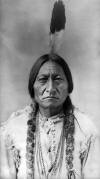 Sitting
Bull Sitting
Bull |
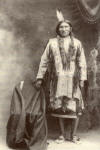 Kicking
Bear Kicking
Bear |
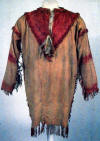 Ghost
Shirt Ghost
Shirt |
Wounded Knee I
A Miniconjou (Lakota) leader named Bigfoot
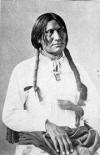 was
an ardent follower of the Ghost Dance and eventually his band of around 380 were
intercepted on the way to the Pine Ridge Agency by the US Army 7th Cavalry. On
Dec 28, 1890 the band was forced to camp on Wounded Knee Creek, SD. The next
morning, Dec 29, they found themselves surrounded by soldiers with rifles and
several rapid fire Hotchkiss repeating cannon. When the soldiers disarmed the Miniconjou, shots were fired and the soldiers opened up with their rifles and
the Hotchkiss guns killing around 300 men, women and children. Many children
that surrendered were gunned down when they came out of hiding. The few wounded
survivors were taken to a makeshift first aid station in a church. One of the
physicians in attendance was a you Santee Sioux, recently graduated from medical
school. His name was Charles Eastman and he later wrote of this experience.
was
an ardent follower of the Ghost Dance and eventually his band of around 380 were
intercepted on the way to the Pine Ridge Agency by the US Army 7th Cavalry. On
Dec 28, 1890 the band was forced to camp on Wounded Knee Creek, SD. The next
morning, Dec 29, they found themselves surrounded by soldiers with rifles and
several rapid fire Hotchkiss repeating cannon. When the soldiers disarmed the Miniconjou, shots were fired and the soldiers opened up with their rifles and
the Hotchkiss guns killing around 300 men, women and children. Many children
that surrendered were gunned down when they came out of hiding. The few wounded
survivors were taken to a makeshift first aid station in a church. One of the
physicians in attendance was a you Santee Sioux, recently graduated from medical
school. His name was Charles Eastman and he later wrote of this experience. Two
days later Eastman and others went out to the site of the massacre and found
among the frozen bodies a few infants still alive. One little girl was named
'Lost Bird' and later wrote an autobiography. Many in the East were incensed at
the harshness of the action and wondered whether it was simply an act of revenge
by the 7th Cavalry for the Little Bighorn defeat. To Native Americans Wounded
Knee became a symbol for the loss of sacred power. The Lakota holy man, Black
Elk, saw Wounded Knee as the fulfillment of his vision of when the 'Sacred Hoop"
would be broken.
Two
days later Eastman and others went out to the site of the massacre and found
among the frozen bodies a few infants still alive. One little girl was named
'Lost Bird' and later wrote an autobiography. Many in the East were incensed at
the harshness of the action and wondered whether it was simply an act of revenge
by the 7th Cavalry for the Little Bighorn defeat. To Native Americans Wounded
Knee became a symbol for the loss of sacred power. The Lakota holy man, Black
Elk, saw Wounded Knee as the fulfillment of his vision of when the 'Sacred Hoop"
would be broken.
Wounded Knee II
In the 1960s the conflict of Vietnam and the
Civil Right's Movement, Native Americans caught in urban slums started becoming
aware of the treatment of Native American a century earlier. A popular book at
the time called Bury My Heart At Wounded Knee
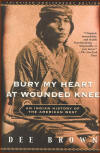 emphasized a Native
American view to the Indian Wars of the West. These urban Indians formed a civil
rights group called the American Indian Movement (AIM). In various protests AIM
tried to bring attention to the plight of broken treaties and promises. AIM took
over the abandoned federal prison Alcatraz in 1969 and marched on Washington DC
to take over the Bureau of Indian Affairs (BIA). The news media began to portray
AIM as radical and the FBI began to target the group. AIM decided to return to
their roots and traveled to the Pine Ridge Reservation to seek spiritual
rejuvenation and guidance. In Feb 1973 AIM took over the hamlet of Wounded Knee
emphasized a Native
American view to the Indian Wars of the West. These urban Indians formed a civil
rights group called the American Indian Movement (AIM). In various protests AIM
tried to bring attention to the plight of broken treaties and promises. AIM took
over the abandoned federal prison Alcatraz in 1969 and marched on Washington DC
to take over the Bureau of Indian Affairs (BIA). The news media began to portray
AIM as radical and the FBI began to target the group. AIM decided to return to
their roots and traveled to the Pine Ridge Reservation to seek spiritual
rejuvenation and guidance. In Feb 1973 AIM took over the hamlet of Wounded Knee
 in protest of a trial of a murder of a local Indian where the murderer only got
man slaughter. This action led to a 71 day siege with federal troops surrounding
the barricaded AIM members and two AIM activists killed by sniper fire.
in protest of a trial of a murder of a local Indian where the murderer only got
man slaughter. This action led to a 71 day siege with federal troops surrounding
the barricaded AIM members and two AIM activists killed by sniper fire.
 AIM's
demands for the Ft. Laramie Treaty to be honored included the return of Lakota
lands. Through negotiation the siege was ended but the federal government did
not meet their promises and harassed AIM members. A virtual civil war griped
Pine Ridge Reservation between AIM supporters and FBI funded supporters. In 1975
at the small hamlet of Ogallala on Pine Ridge a shoot out between AIM members
and the FBI resulted in 2 AIM members and 2 FBI agents killed. This launched a
huge manhunt and Leonard Peltier was hunted down in Canada and broke back to the
US for trial . Peltier was found guilty of the FBI killings and given to a
double life sentence. Later, it was found that the FBI withheld and tampered
with evidence to frame Peltier. Peltier's weapon did not kill the FBI agents,
but although Peltier claims he knows who did it, he refuses to reveal the name(s).
At Pine Ridge the civil war subsided and AIM has become less active. Some
reservation based Native Americans have never liked the radical approach of AIM
and found it to be an urban movement that should never have interfered with
tribal politics. Yet, on the flip side AIM did bring attention to the problems
of America's "unfinished business". On Pine Ridge anniversary marches are held
for Wounded Knee I & II with the 1990 100th Anniversary being the most
important.
AIM's
demands for the Ft. Laramie Treaty to be honored included the return of Lakota
lands. Through negotiation the siege was ended but the federal government did
not meet their promises and harassed AIM members. A virtual civil war griped
Pine Ridge Reservation between AIM supporters and FBI funded supporters. In 1975
at the small hamlet of Ogallala on Pine Ridge a shoot out between AIM members
and the FBI resulted in 2 AIM members and 2 FBI agents killed. This launched a
huge manhunt and Leonard Peltier was hunted down in Canada and broke back to the
US for trial . Peltier was found guilty of the FBI killings and given to a
double life sentence. Later, it was found that the FBI withheld and tampered
with evidence to frame Peltier. Peltier's weapon did not kill the FBI agents,
but although Peltier claims he knows who did it, he refuses to reveal the name(s).
At Pine Ridge the civil war subsided and AIM has become less active. Some
reservation based Native Americans have never liked the radical approach of AIM
and found it to be an urban movement that should never have interfered with
tribal politics. Yet, on the flip side AIM did bring attention to the problems
of America's "unfinished business". On Pine Ridge anniversary marches are held
for Wounded Knee I & II with the 1990 100th Anniversary being the most
important.
 Memorial
march 1993 Memorial
march 1993 |
 |
 |
5. Maya Rebellion 1994
Much of the history of the Americas since Columbus has been written the colonial conquerors. Even the rebellions we have described are seldom included in mainstream history books, especially textbooks. Native American are viewed as dead or invisible.
The classical Maya recorded the history of their civilization in books, on stone and on ceramics. Only recently have we been able to decipher the Maya hieroglyphics. They recorded detailed history of rulers and events intertwined with mythical references. As colonial New Spain evolved into the nations of Mexico, Guatemala and Honduras Native Americans or indigenous people were not give a voice nor were they included in written history. Even when education came to local indigenous communities, local history was not included in the curriculum. Local Maya people and culture was viewed by the government and the church as worthless, idolatrous and superstitious even into the 1950s through today. The Maya, like the Tzolzil and Zinacanteca had been keeping track of local history through village historians who were responsible for maintaining a oral memory. The civil rights movements in the US influenced many groups to form grass roots organizations, usually referred to as in indigenous congresses. These organizations recognized the need to teach traditional culture, language and history. Basically, indigenous knowledge was seen not only of having value but essential for building cultural esteem and sovereignty. In Chiapas, Mexico and other areas emerged a revival of traditional knowledge and demands for government reform especially in education and land tenure.
In the 1980s a mysterious outsider, only known as Marcos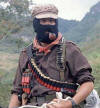 came
to live among the Maya of Chiapas, Mexico. Marcos revitalized an old rebel group
known as the Zapatista Army of National Liberation. An indication of the brewing
rebellion was noted when a group of protestors marched into the colonial city of
San Cristobal de las Casas on Oct 12, 1992 (500 years after Columbus' arrival
to the New World) and knocked down a statue of conquistador Diego de Mazariegos.
The statue was smashed to bit with sledge hammers and protestors retreated
to the mountains with souvenirs of the historical event. It seemed as if these
Maya protestors were well aware of the significance of the history of five
centuries of oppression.
came
to live among the Maya of Chiapas, Mexico. Marcos revitalized an old rebel group
known as the Zapatista Army of National Liberation. An indication of the brewing
rebellion was noted when a group of protestors marched into the colonial city of
San Cristobal de las Casas on Oct 12, 1992 (500 years after Columbus' arrival
to the New World) and knocked down a statue of conquistador Diego de Mazariegos.
The statue was smashed to bit with sledge hammers and protestors retreated
to the mountains with souvenirs of the historical event. It seemed as if these
Maya protestors were well aware of the significance of the history of five
centuries of oppression.
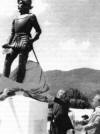 1978
dedication of Mazariegos statue 1978
dedication of Mazariegos statue |
 1992
riot and Mazariegos statue rmoval 1992
riot and Mazariegos statue rmoval |
 Modern
Zapatista Army Modern
Zapatista Army |
The Chiapas area was settled by Diego de Mazariegos in 1528 and eventually he established the town of San Cristobal as a center to the highland area. However, the nature of his conquest and colonial imposition of the encomienda imposed on the surrounding Maya villages is not at all clear. The remnants of the Maya Empire were small highland villages with local ruler ship. Some colonial historians portray Mazariegos as milder conquistador that was protector of the 'naturales' (Indians); while other historians argue that slavery was rampant and that the 'encomenderos' (those that were given encomiendas or tribute rights) were no better than slavers. The 'encomenderos' created an economic gimmick to consistently keep the local village Indians in debt by cheating them in all trade deals and pay. Furthermore, disease reduced the Maya population by 2/3 in the first fifty years of colonization. The legendary priest, turned bishop, Bishop de Las Casas spent two years (1545-1547) in Chiapas and tried to stop slavery with little success. The local land owners/encomenderos saw Las Casas as barrier to progress and blamed his clerics for labor shortages and lost revenue. Las Casas was forced to leave and took his fight to the courts in Spain. In Chiapas the Spanish controlling families continued their economic suppression with the trade of Indian produced raw material, like cacao, cotton and tobacco, exchanged for high priced finished goods that with added credit kept the Maya always indebt. San Cristobal was the center of this exploitive system and people were eventually pushed into starvation. Conditions led to the 1712 Tzeltal (Maya) uprising that is considered the bloodiest in Meso-American history. the abuse continued and by the mid 1800s the press in Mexico City cited Chiapas as a 'slave state'. This was part of the fuel for the Mexican Revolution of 1910-1920, but change did not come to Chiapas. After the revolution the Mexican government's Dept. of Indigenous Affairs acknowledged continued slavery in Chiapas. So when San Cristobal leaders erected a statue of Mazariegos in 1978 it was an obvious symbol of denial of the reality of past history. At various times anthropologists and Marxist activists have used the Chiapas arena as an example of the continued oppression of indigenous people. However, they have never made good on any promises to get change. Many religious groups including evangelical Christians and the catholic church have maintained missionary efforts but seem to impotent in getting meaningful change. The Maya people really do not want any of these people but have found some provision and health benefits to their presence. The truth is that the Maya people want control of their own destiny, sovereignty, and they know the must gain it for themselves. they have to write their own history and make their own history. That is the impetus and reason for their action on Oct 12, 1992.
On New Years' Day 1994 the world was stunned when indigenous rebels of the Zapatista Army of National Liberation seized four cities in Chiapas, including San Cristobel. The name of the rebel group, Zapatista Army of National Liberation (Ejercito Zapatista de Liberacion Nacional, EZLN) comes from Emiliano Zapata the commander during the Mexican Revolution. Strangely enough the group retreated into the mountains after taking the four cities, chased by 12,000 Mexican troops, but have ceased using weapons. Instead they (EZLN) and their enigmatic leader Marcos have sought international support for their cause. They have made a series of declarations of their demands and meetings with other indigenous groups. The latest meeting was "Third Encuentro of the Zapatistas with the People of the World" on Dec 28, 2007-Jan 1, 2008.